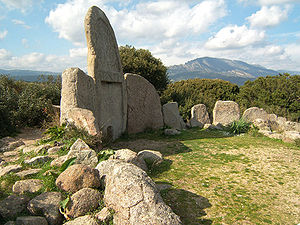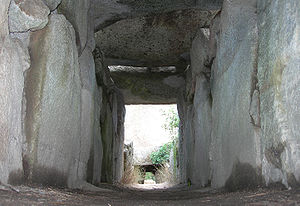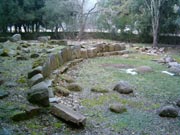
Giants' grave
Encyclopedia


Sardinia
Sardinia is the second-largest island in the Mediterranean Sea . It is an autonomous region of Italy, and the nearest land masses are the French island of Corsica, the Italian Peninsula, Sicily, Tunisia and the Spanish Balearic Islands.The name Sardinia is from the pre-Roman noun *sard[],...
n megalithic gallery grave
Gallery grave
A Gallery grave is a form of Megalithic tomb where there is no size difference between the burial chamber itself and the entrance passage. Two parallel walls of stone slabs were erected to form a corridor and covered with a line of capstones. The rectangular tomb was covered with a barrow or a cairn...
built during the Bronze Age
Bronze Age
The Bronze Age is a period characterized by the use of copper and its alloy bronze as the chief hard materials in the manufacture of some implements and weapons. Chronologically, it stands between the Stone Age and Iron Age...
by the Nuragic civilization
Nuragic civilization
The Nuragic civilization was a civilization of Sardinia, lasting from the Bronze Age to the 2nd century AD. The name derives from its most characteristic monuments, the nuraghe. They consist of tower-fortresses, built starting from about 1800 BC...
. They can be found throughout Sardinia
Sardinia
Sardinia is the second-largest island in the Mediterranean Sea . It is an autonomous region of Italy, and the nearest land masses are the French island of Corsica, the Italian Peninsula, Sicily, Tunisia and the Spanish Balearic Islands.The name Sardinia is from the pre-Roman noun *sard[],...
, and so far 321 have been discovered.
A stone cairn
Cairn
Cairn is a term used mainly in the English-speaking world for a man-made pile of stones. It comes from the or . Cairns are found all over the world in uplands, on moorland, on mountaintops, near waterways and on sea cliffs, and also in barren desert and tundra areas...
lies over the burial chamber itself. Some examples have a cup-shaped entrance similar to the court cairn
Court cairn
The court cairn or court tomb is a megalithic type of chamber tomb and gallery grave, specifically a variant of the chambered cairn, found in western and northern Ireland, and in mostly southwest Scotland...
tombs of Ireland
Ireland
Ireland is an island to the northwest of continental Europe. It is the third-largest island in Europe and the twentieth-largest island on Earth...
.

In the so-called "slab type", uncut slabs are buried on end in the ground, and are arranged side-by-side. There is usually a central stele
Stele
A stele , also stela , is a stone or wooden slab, generally taller than it is wide, erected for funerals or commemorative purposes, most usually decorated with the names and titles of the deceased or living — inscribed, carved in relief , or painted onto the slab...
, which is the largest (up to 4 m in height) slab and has a doorway cut through it. The sepulchre
Sepulchre
The rock-cut tombs in ancient Israel are a group of hundreds of rock-cut tombs constructed in Israel in ancient times. They were cut into the rock, sometimes with elaborate facades and multiple burial chambers. Some are free-standing, but most are caves. Each tomb typically belonged to a...
s have a characteristic rectangular plan with an apse
Apse
In architecture, the apse is a semicircular recess covered with a hemispherical vault or semi-dome...
. The burial chamber is usually 5 to 15 metres long and 1 to 2 metres high. The structures were originally covered by a mound resembling the shape of an overturned ship. Near the entrance was an obelisk
Obelisk
An obelisk is a tall, four-sided, narrow tapering monument which ends in a pyramid-like shape at the top, and is said to resemble a petrified ray of the sun-disk. A pair of obelisks usually stood in front of a pylon...
(betile in Sardinian
Sardinian language
Sardinian is a Romance language spoken and written on most of the island of Sardinia . It is considered the most conservative of the Romance languages in terms of phonology and is noted for its Paleosardinian substratum....
), which symbolizes the gods or ancestors who watched over the dead.
In the more primitive slab-type giant's tombs, the central slab is unmodified aside from the entrance that is cut through it at the base, or else there is a crude dolmen-like arrangement of 3 uncut rocks to form the entrance (Osono, Sortali, Lolghi, Pescaredda).
In a more advanced slab-type giant's tombs, the central slab is modified so as to be rounded on top, and has a simple design carved into the front surface (Dorgali, Goronna, Santu Bainzu, Coddu Vecchju).
The so-called "block type" is made of rectangular-cut blocks (Bidistili, Madau II, Seleni II, Iloi, Mura Cuata).
There is also a structure similar to a block-type giant's tomb on the island of Malta
Malta
Malta , officially known as the Republic of Malta , is a Southern European country consisting of an archipelago situated in the centre of the Mediterranean, south of Sicily, east of Tunisia and north of Libya, with Gibraltar to the west and Alexandria to the east.Malta covers just over in...
.
List of major tombs
- Su Mont'e s'Abe, near OlbiaOlbiaOlbia is a town and comune of 56,231 inhabitants in northeastern Sardinia , in the Gallura sub-region. Called Olbia in the Roman age, Civita in the Middle Ages and Terranova Pausania before the 1940s, Olbia was again the official name of the town after the period of Fascism.-Geography:It is the...
- Sa Dom'è s'Orcu, near QuartucciuQuartucciuQuartucciu is a comune in the Province of Cagliari in the Italian region Sardinia, located about 8 km northeast of Cagliari.-History:Before the fall of the Western Roman Empire, Quartucciu was attacked by the Vandals...
- Two 18th century BC18th century BCThe 18th century BCE was the century which lasted from 1800 BCE to 1701 BCE.-Events:*1800 BCE: Iron age in India*1800 BCE: Beginning of the Nordic Bronze Age in the period system devised by Oscar Montelius....
tombs near LanuseiLanuseiLanusei is a town and comune in Sardinia, co-capital of the Province of Ogliastra with Tortolì.... - Aiodda, near NurallaoNurallaoNurallao is a comune in the Province of Cagliari in the Italian region Sardinia, located about 60 km north of Cagliari. As of 31 December 2004, it had a population of 1,404 and an area of 34.7 km²....
- Coddu Vecchju and Li Lolghi, ArzachenaArzachenaArzachena is a town and comune in the province of Olbia-Tempio, Sardinia, Italy. Arzachena is very close to the famous "Costa Smeralda" tourist area, and it is the administrative capital of the "Costa Smeralda" tourist area....
- Sa Dom´e S´Orku, SiddiSiddiThe Siddi, Siddhi, or Sheedi , also known as Habshi, are an Indian and Pakistani ethnic group of Afro-Arab and/or Black African descent. The Siddi population is currently estimated to be 20,000–55,000, with Gujarat and Hyderabad in India the main population centre. Siddis are mainly Sufi Muslims,...
- Imbertighe, BororeBororeBorore is a comune in the Province of Nuoro in the Italian region Sardinia, located about 110 km north of Cagliari and about 50 km west of Nuoro....
- Madau, FonniFonniFonni is a town and comune in Sardinia, in the province of Nuoro .It is the highest town in Sardinia, and situated among fine scenery with some chestnut woods. Fonni is a winter sports centre with a ski lift to Monte Spada and Bruncu Spina....
- Muraguada, BauladuBauladuBauladu is a comune in the Province of Oristano in the Italian region Sardinia, located about 100 km northwest of Cagliari and about 15 km northeast of Oristano. As of 31 December 2004, it had a population of 732 and an area of 24.2 km².Bauladu borders the following municipalities:...
- Osono, near TrieiTrieiTriei is a comune of c. 1,000 inhabitants in the province of Ogliastra in the Italian region Sardinia, located about 100 km northeast of Cagliari and about 11 km north of Tortolì....
- Tomb of San Cosimo, near GonnosfanadigaGonnosfanadigaGonnosfanadiga is a town and comune in the province of Medio Campidano, Sardinia, Italy. It is located between Medio Campidano plain from NE and the Monte Linas massif from SE....
- Ena ´e Thomes, DorgaliDorgalithumb|250px|[[Giants' grave]] of Sa Ena e Thomes.Dorgali is a comune in the Province of Nuoro in the Italian region Sardinia, located about 230 km northeast of Cagliari and about 38 km east of Nuoro in the Seaside Supramonte mountain area.Economy is mostly based on the vine and wine...
- Bainzu, BororeBororeBorore is a comune in the Province of Nuoro in the Italian region Sardinia, located about 110 km north of Cagliari and about 50 km west of Nuoro....
- Sa Farch´e S´Artare, SenegheSenegheSeneghe is a comune in the Province of Oristano in the Italian region Sardinia, located about 110 km northwest of Cagliari and about 20 km north of Oristano. As of 31 December 2004, it had a population of 1,944 and an area of 57.8 km².Seneghe borders the following municipalities:...

